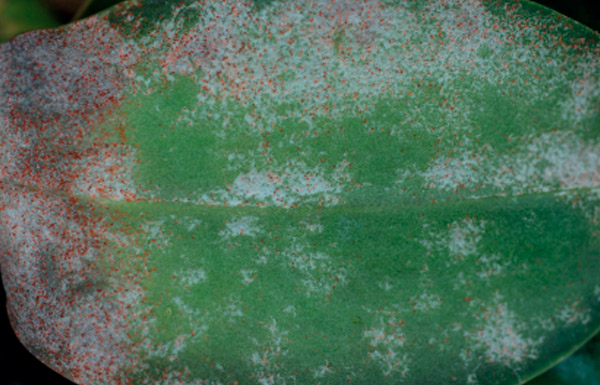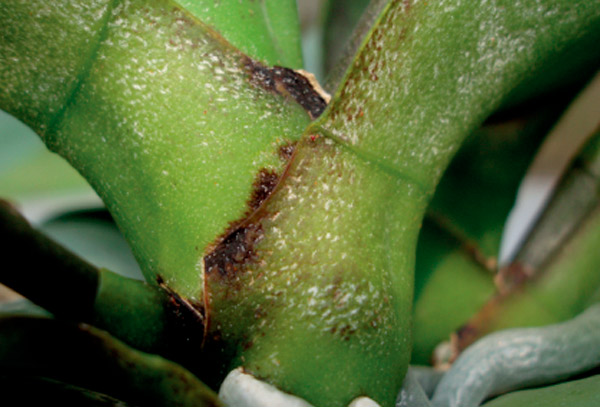Flat mite on orchids
Last reviewed: 29.06.2025

Flat mite on orchids is a relatively rare but highly dangerous pest that can cause significant harm to your plants. This pest belongs to the arachnid family and has a flat, oval body that allows it to hide in hard-to-reach areas of the orchid. Infestation by flat mites on orchids can lead to noticeable damage, slow growth, reduced blooming, and even death of the plant if not addressed in time. In this article, we will discuss in detail how to identify flat mites on orchids, their symptoms, causes of appearance, and effective control methods.
What is a flat mite?
The flat mite (genus tetranychidae) is a small, flat mite that prefers to infest orchids under high temperature and low humidity conditions. These mites can be red, yellowish, or brown in color, making them quite noticeable upon close inspection or in photos. Flat mites are sap-sucking pests, feeding on plant cell fluids, causing damage to orchid leaves, stems, and flowers.
Like other types of mites, flat mites on orchids typically hide on the underside of the leaves, in stems, and even within flower buds, where they can be spotted only upon close inspection or with a magnifying glass. These mites reproduce quickly, which can result in a rapid spread of the infestation to the entire orchid and other neighboring plants.
How does a flat mite on orchids look?
Photos of flat mites on orchids allow you to clearly observe their features. The mite is tiny (0.2 to 0.5 mm), making it difficult to spot with the naked eye, but its red or yellowish hue is visible when magnified. The mite has a flat, oval body, which allows it to hide in the smallest crevices and folds on the leaves, between the stems, and even in the orchid's flowers. Under a microscope or with a magnifying glass, you can see the mite piercing the plant's cells and sucking out their fluids, causing damage to the tissues.

Life cycle of the flat mite on orchids (family tenuipalpidae)
The flat mite ( brevipalpus spp.) Is a dangerous pest of orchids that feeds on plant cell sap. Its infestation manifests as yellowish spots, dry patches, and overall plant wilting. Understanding its life cycle helps to implement effective control measures.
Stages of the flat mite's life cycle
1. Egg
Females lay eggs on the underside of leaves, along leaf veins, and in leaf axils of orchids. The eggs are small, round, orange, or reddish and are well-protected from chemical treatments.
- Duration: 7–10 days (at +25…+30°c).
2. Larva
Larvae emerge from eggs and are oval-shaped with three pairs of legs and a light, almost transparent appearance. They become mobile immediately and begin feeding by piercing leaf tissues.
- Duration: 5–7 days.
3. Nymph (protonymph and deutonymph)
The larvae go through two nymphal stages: protonymph (first nymphal stage) and deutonymph (second stage). Nymphs are larger, reddish, and have four pairs of legs. They become less mobile but continue feeding, causing leaf yellowing and drying.
- Duration of each stage: 4–8 days.
4. Adult mite (imago)
Adult mites have flattened, oval bodies, reddish or brown in color. Females are significantly larger than males and live from 2 to 4 weeks. Each female lays up to 100 eggs during her lifetime.
- Lifespan: 20–40 days (depending on temperature and humidity).
Factors affecting flat mite development
- Temperature: the optimal temperature for reproduction is +25…+30°c.
- Humidity: mites prefer dry conditions and struggle to survive in humidity above 80%.
- Host plants availability: orchids with weakened immunity are more susceptible to infestations.
Signs of flat mite infestation on orchids
Early detection of flat mites is crucial for effective pest control. Here are the main signs of infestation:
- Yellowing and spots on leaves: the first signs of infestation include the appearance of small yellow spots that gradually enlarge and may turn brown. These spots are caused by the mites feeding on the plant’s cells.
- Brown or red spots: as the mites continue feeding, brown or red spots appear on the leaves. In some cases, these spots may merge, causing extensive damage.
- Spider webs: one of the characteristic signs of a severe infestation of mites is the appearance of thin spider webs on the leaves and stems of the orchid. The webs are often barely noticeable but may cover the underside of the leaves or other areas of the plant.
- Slowed growth and wilting: orchids infested with flat mites exhibit slow growth. The leaves become dull and less likely to produce new growth, and blooming may cease or be significantly reduced. This happens because the mites are draining nutrients from the plant, weakening its overall health.
- Leaf drop: in cases of severe infestation, orchid leaves begin to yellow, dry out, and fall off. This can result in partial or complete leaf loss, further weakening the plant.

Why do flat mites appear on orchids?
Flat mites prefer dry, warm conditions for reproduction. The main causes of flat mite infestation on orchids are:
- Dry air: mites thrive in dry conditions where humidity is below 50%. Therefore, if the air in your home is too dry, the likelihood of an infestation increases.
- Poor ventilation: when plants are placed too close to each other, and the air does not circulate well, it creates ideal conditions for mites to spread. Proper ventilation is essential to prevent infestations.
- Improper care: overwatering or inadequate watering, incorrect placement of orchids (e.g., hot, sunny spots without airflow) can weaken the plant and make it more susceptible to pests like flat mites.
- Stagnant water: excessive watering and standing water in the pot tray also make orchids more vulnerable to pests, including flat mites.
- Infestation from new plants: bringing new orchids or other plants into your home can introduce pests. New plants may appear healthy but can be infested with mites.
How to control flat mites on orchids?
Controlling flat mites on orchids requires quick action and the use of several methods to ensure complete elimination of the pests. Here are effective ways to get rid of flat mites on orchids:
- Manual removal: at the first signs of flat mite infestation, you can manually remove them by using a damp cloth or cotton pad soaked in soapy water. Gently wipe the affected areas, especially the undersides of the leaves where the mites usually hide. Repeat this process regularly until all visible mites are removed.
- Insecticidal soap: insecticidal soap is an excellent solution for dealing with flat mites. It is safe for plants and effectively kills the mites without harming the orchid. Spray the entire plant, including the leaves, stems, and roots.
- Neem oil: neem oil is a natural remedy that not only kills the mites but also creates a protective barrier on the leaves, preventing reinfestation. It is safe for plants and pets.
- Using acaricides: in cases of severe infestation, acaricides (miticides) may be required. These chemicals are effective in killing mites at different stages of their life cycle. Always follow the instructions on the label and take appropriate safety precautions when using chemicals.
- Increasing humidity: flat mites prefer dry conditions, so increasing the humidity around the orchid can help repel them. Use a humidifier or mist the plant regularly, but ensure that water does not collect in the leaf axils, which could lead to rot.
- Isolating infected plants: if you notice flat mites on one of your orchids, isolate the infected plant from others to prevent the pests from spreading. Mites can easily move from plant to plant, especially in crowded conditions.
Preventing flat mite infestation on orchids
It is much easier to prevent flat mites than to deal with an infestation. Here are some preventive measures that can help keep your orchids free from pests:
- Regularly inspect your plants: check your orchids regularly for signs of flat mites, especially on the undersides of the leaves and in hidden areas. Early detection allows for quicker treatment and prevents pests from spreading.
- Provide optimal growing conditions: ensure that your orchids are kept in ideal conditions, including proper watering, good ventilation, and moderate humidity, to make them less susceptible to mites.
- Quarantine new plants: before introducing new orchids into your collection, quarantine them for a few weeks to ensure they are free of pests. This helps prevent flat mites and other pests from spreading to your existing plants.
- Cleanliness and maintenance: keep your orchids clean by regularly wiping the leaves with a damp cloth to remove dust and potential pests. This will also help you spot early signs of problems.
Conclusion
Flat mites on orchids can be persistent and damaging pests, but with early detection and prompt action, they can be effectively controlled. By recognizing symptoms such as yellow or brown spots, webs, slowed growth, and leaf drop, you can act quickly to eliminate the pests. Methods like manual removal, insecticidal soap, neem oil, and acaricides are effective in controlling flat mites. Preventive measures such as regular inspections, providing the right growing conditions, and quarantining new plants can help keep your orchids healthy and free from these harmful pests.
